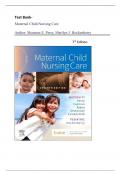Test Bank-
Maternal Child Nursing Care
Author: Shannon E. Perry, Marilyn J. Hockenberry
7th Edition
,Table Of Contents
Chapter 01: 21st Century Maternity Nursing
Chapter 02: Community Care: The Family And Culture
Chapter 03: Assessment And Health Promotion
Chapter 04: Reproductive System Concerns
Chapter 05: Infertility, Contraception, And Abortion
Chapter 06: Genetics, Conception, And Fetal Development
Chapter 07: Anatomy And Physiology Of Pregnancy
Chapter 08: Nursing Care Of The Family During Pregnancy
Chapter 09: Maternal And Fetal Nutrition
Chapter 10: Assessment Of High Risk Pregnancy
Chapter 11: High Risk Perinatal Care: Preexisting Conditions
Chapter 12: High Risk Perinatal Care: Gestational Conditions
Chapter 13: Labor And Birth Processes
Chapter 14: Pain Management
Chapter 15: Fetal Assessment During Labor
Chapter 16: Nursing Care Of The Family During Labor And Birth
Chapter 17: Labor And Birth Complications
Chapter 18: Maternal Physiologic Changes
Chapter 19: Nursing Care Of The Family During The Postpartum Period
Chapter 20: Transition To Parenthood
Chapter 21: Postpartum Complications
Chapter 22: Physiologic And Behavioral Adaptations Of The Newborn
Chapter 23: Nursing Care Of The Newborn And Family
Chapter 24: Newborn Nutrition And Feeding
Chapter 25: The High Risk Newborn
Chapter 26: 21st Century Pediatric Nursing
Chapter 27: Family, Social, Cultural, And Religious Influences On Child Health Promotion
,Chapter 28: Developmental And Genetic Influences On Child Health Promotion
Chapter 29: Communication, History, And Physical Assessment
Chapter 30: Pain Assessment And Management In Children
Chapter 31: The Infant And Family
Chapter 32: The Toddler And Family
Chapter 33: The Preschooler And Family
Chapter 34: The School-Age Child And Family
Chapter 35: The Adolescent And Family
Chapter 36: Impact Of Chronic Illness, Disability, And End-Of-Life Care For The Child And Family
Chapter 37: Impact Of Cognitive Or Sensory Impairment On The Child And Family
Chapter 38: Family-Centered Care Of The Child During Illness And
Chapter 39: Pediatric Variations Of Nursing Interventions
Chapter 40: Respiratory Dysfunction
Chapter 41: Gastrointestinal Dysfunction
Chapter 42: Cardiovascular Dysfunction
Chapter 43: Hematologic And Immunologic Dysfunction
Chapter 44: Cancer
Chapter 45: Genitourinary Dysfunction
Chapter 46: Cerebral Dysfunction
Chapter 47: Endocrine Dysfunction
Chapter 48: Musculoskeletal Or Articular Dysfunction
Chapter 49: Neuromuscular Or Muscular Dysfunction
, Chapter 01: 21st Century Maternity Nursing
MULTIPLE CHOICE
1. When Providing Care For A Pregnant Woman, The Nurse Should Be Aware That One Of The
Most Frequently Reported Maternal Medical Risk Factors Is:
A. Diabetes Mellitus. C. Chronic Hypertension.
B. Mitral Valve Prolapse (MVP). D. Anemia.
CORRECT ANSWER: A
The Most Frequently Reported Maternal Medical Risk Factors Are Diabetes And Hypertension
Associated With Pregnancy. Both Of These Conditions Are Associated With Maternal Obesity. There Are
No Studies That Indicate MVP Is Among The Most Frequently Reported Maternal Risk Factors.
Hypertension Associated With Pregnancy, Not Chronic Hypertension, Is One Of The Most Frequently
Reported Maternal Medical Risk Factors. Although Anemia Is A Concern In Pregnancy, It Is Not One Of
The Most Frequently Reported Maternal Medical Risk Factors In Pregnancy.
PTS: 1 DIF: Cognitive Level: Knowledge REF: 6
OBJ: Nursing Process: Assessment MSC: Client Needs: Physiologic Integrity
2. To Ensure Optimal Outcomes For The Patient, The Contemporary Maternity Nurse Must
Incorporate Both Teamwork And Communication With Clinicians Into Her Care Delivery, The SBAR
Technique Of Communication Is An Easy-To-Remember Mechanism For Communication. Which Of The
Following Correctly Defines This Acronym?
A. Situation, Baseline Assessment, Response
B. Situation, Background, Assessment, Recommendation
C. Subjective Background, Assessment, Recommendation
D. Situation, Background, Anticipated Recommendation
B




